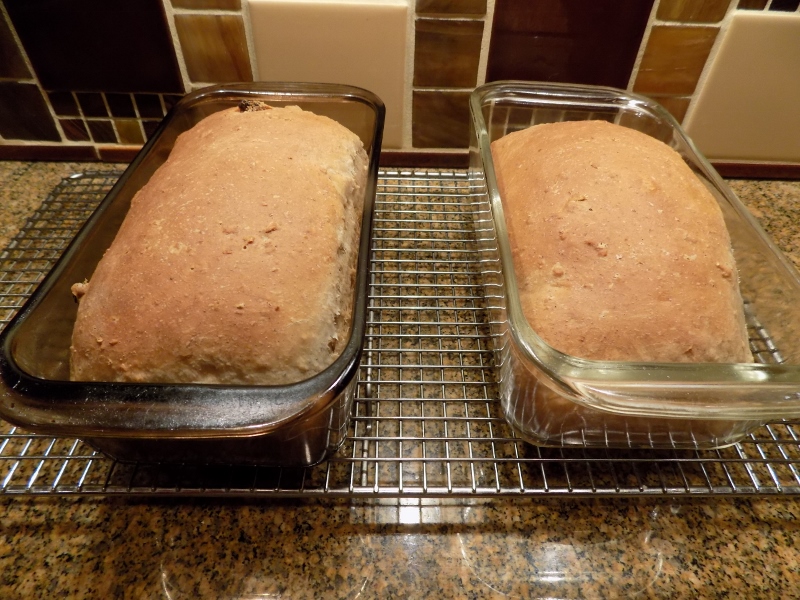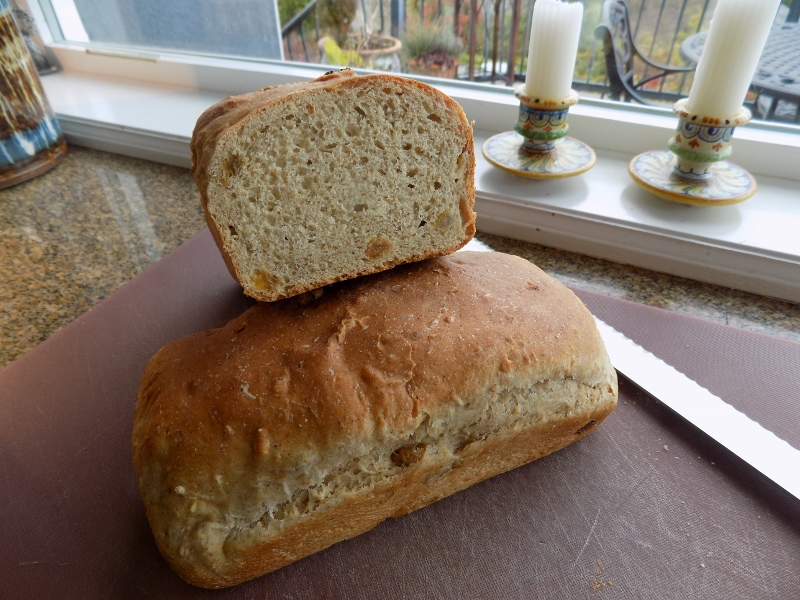I know, another bread recipe! But in my defense, I have a new sourdough starter that I am trying to keep alive. So I’ve decided that I am going to bake bread weekly. That way I can use my starter (my sister-in-law named the starter Geneviève) and monitor the nutritional value in every single piece of toast we eat each morning. And yes, there is a huge difference in the nutritional value of different types of bread. Even homemade bread. Mostly it’s from the type and brand of flour used, and of course the added ingredients such as raisins, seeds, oats, and nuts.
King Arthur, Red Mill, Stone-Buhr, Bluebird Grain Farms (Winthrop, WA), and the Central Milling Company organic unbleached, all-purpose flour carried by Costco are my personal favorites. And as much as possible I plan to incorporate organic whole wheat and rye flour into my recipes for both their flavor and nutritional contribution.
Both white and wheat flour are made from wheat berries. Wheat berries have three nutrient rich parts – the bran (outer layer), the germ (the inner most part), and the endosperm (the starchy part in between). White flour consists of just the endosperm, while whole wheat (thus its name) uses all three parts. Therefore whole wheat flour is much higher in fiber, folic acid, chromium, zinc, magnesium, vitamin B6, and vitamin E. And rye berries just happen to be one of the healthiest grains in the world. Using rye flour reportedly helps fight against diabetes, cardiovascular disease, weight gain, cancer, inflammation, and high blood pressure. (Source – Dr. Axe)
Most of the time we only have bread with breakfast. Occasionally we will share a sandwich for lunch, but only on rare occasions. So mostly we eat a slice a day in the form of toast. So when deciding what type of bread to try this week, I decided on raisin bread.
During my research, many of the recipes for raisin bread had you create a swirl by flattening out the dough and then sprinkling on the raisins and rolling the loaf like a cinnamon roll. Nice presentation, but too much work. So I just incorporated the raisins and cinnamon into the dough. (Same flavors, but less work.) So really, this bread comes together very quickly.
So, in short, this is not the only bread recipe I am going to post in the next few weeks. And yes I know, there are thousands of wonderful homemade bread recipes already on the internet. But I try to keep my bread recipes as healthy and easy to prepare as possible. And you’re right! Many of you are never going to bake your own bread, either because you have no desire to do so, or simply haven’t got the time. I truly understand. But for those of you who are teetering towards bread baking, I hope you give any of the bread recipes on this site a try. They are mostly quite easy to prepare and in the long run can save you money.
I did a quick and dirty cost analysis based on a basic French bread using King Arthur flour. I came up with about $1.70 worth of ingredients and cost to run our oven. ($.80 flour, $.38 yeast, $.02 salt, water, and fuel $.50.) To buy a truly good artisanal loaf weighing over a pound, you can expect to spend anywhere from $4-8. And even then, the quality of the ingredients used to prepare the bread is unknown. So if you want to have your bread and eat it too, get thee to the kitchen at your earliest convenience. If you have bread baking questions, you can always direct them to me by clicking on the “leave a reply” link. If you have questions about ship building or sports statistics for example, don’t bother!
- ¾ c. sourdough starter (see recipe below)
- 2½ tsp. active dry yeast
- 2/3 c. room temperature water
- ¼ c. brown sugar
- 5 T. unsalted butter, room temperature
- 1¼ tsp. fine sea salt
- 1 tsp. ground cinnamon
- 1 lg. egg
- 1 c. whole wheat flour
- ½ c. old-fashioned rolled oats
- ½ c. golden raisins
- 1½ – 2 c. unbleached all-purpose flour
- veggie oil
Combine the sourdough starter, yeast, water, and brown sugar in the bowl of your stand mixer. Stir with your dough hook and let sit for 15 minutes.
Add the butter, salt, cinnamon, egg, whole wheat flour, and oats; beat until well combined. Add the raisins and enough of the all-purpose flour to make a smooth, soft dough.
Add a tiny bit of oil to the mixing bowl, and using your hands, gently form the dough into a ball making certain that the entire surface is lightly coated with the oil. Cover the bowl with plastic wrap and allow it to rise for 1½ to 2 hours, or until just about doubled in bulk.
When the dough is ready, gently deflate the dough, divide in half, form into 2 loaves, and place in two lightly greased 4½ x 8½-inch loaf pans. Cover with a clean tea towel and allow the dough to rise for 1½ hours or until nicely plumped.
Bake in a pre-heated 350 degree oven for 35-40 minutes. When done, the bread’s crust should be a beautiful golden brown, and the interior should measure at least 190 degrees on an instant-read digital thermometer.
Remove the bread from the oven, and gently loosen the edges. Turn onto a wire rack and allow to cool completely before slicing.
Sourdough Starter
- 1 c. unbleached all-purpose flour
- 1 T. sugar
- 1½ tsp. active dry yeast
- 1 c. warm water
Combine all ingredients in a plastic juice pitcher using a wooden or plastic spoon. (Don’t worry about lumps because the little yeasty beasties will make short work of dissolving the lumps!) Cover with lid, turning strainer in lid to pouring lip. (This allows air to reach the starter.) Let ferment 3 days at room temperature, stirring several times daily. After the third day, transfer starter to a covered glass container and refrigerate.
To use, remove desired amount for recipe and replenish starter by stirring in equal amounts of flour and water or follow the instructions for the particular bread you are making. Let stand at room temperature overnight. Return to refrigerator.
If a clear liquid forms on top, stir back into starter. Every time you use, replenish with equal amounts of flour and water. Even if you don’t use every week, replenish every 7 – 10 days with equal amounts flour and water. (First remove about ½ cup of the existing starter. This allows room in your container for the new flour (yeast food) and water.) Use in any of your favorite bread, muffin, or pancake recipes.


